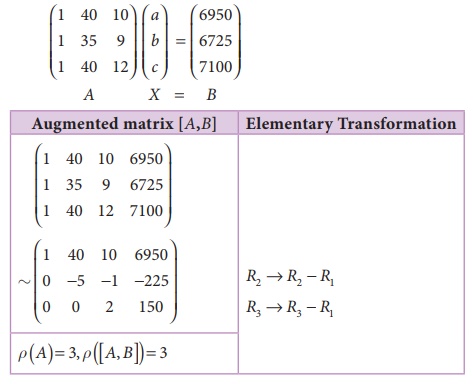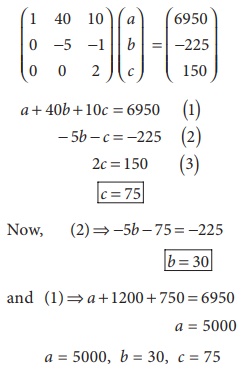with Solved Example Problems - Testing the consistency of non homogeneous linear equations (two and three variables) by rank method | 12th Business Maths and Statistics : Chapter 1 : Applications of Matrices and Determinants
Chapter: 12th Business Maths and Statistics : Chapter 1 : Applications of Matrices and Determinants
Testing the consistency of non homogeneous linear equations (two and three variables) by rank method
Testing the consistency of non homogeneous
linear equations (two and three variables) by rank method.
Consider the equations A X= B in ãnã
unknowns.
(i) If ü ([A, B] )
= ü ( A) , then the equations
are consistent.
(ii) If ü[([A, B] )
= ü ( A )= n , then the
equations are consistent and have unique solution.
(iii) If ü ([ A, B] )
= ü ( A ) < n , then the
equations are consistent and have infinitely many solutions.
(iv) If ü ([A, B ])
ã ü ( A) then the equations are
inconsistent and has no solution.
Example 1.9
Show that the equations x + y =
5, 2x + y = 8 are consistent and
solve them.
Solution:
The matrix equation corresponding to the given system is

AX=B

Number of non-zero rows is 2.
ü (A )= ü ([ A, B]) = 2 = Number of unknowns.
The given system is consistent and has unique solution.
Now, the given system is transformed into

x + y = 5
y = 2
ãÇ (1) ã
x + 2 = 5
x = 3
Solution is x =
3, y = 2
Example 1.10
Show that the equations 2x + y =
5, 4x + 2 y = 10 are consistent and
solve them.
Solution:
The matrix equation corresponding to the system is

ü ( A ) = ü ([ A, B]) = 1 < number of unknowns
ãÇ The given system is
consistent and has infinitely many solutions.
Now, the given system is transformed into the matrix equation.

Let us take y = k, k ãR
ã 2x + k = 5
x = 1/2 ( 5 ã k)
x = 1/2 ( 5 ã k) , y = k for all k ãR
Thus by giving different values for k, we get different
solution. Hence the system has infinite number of solutions.
Example 1.11
Show that the equations 3x ã 2 y =
6, 6x ã 4 y = 10 are inconsistent.
Solution:
The matrix equation corresponding to the given system is

ãÇThe given system is
inconsistent and has no solution.
Example 1.12
Show that the equations 2x + y +
z = 5, x + y + z = 4, x ã y + 2z = 1 are consistent and
hence solve them.
Solution:
The matrix equation corresponding to the given system is

Obviously the last equivalent matrix is in the echelon form. It
has three non-zero
rows.
ü( A ) = ü( [A, B] )= 3 = Number of unknowns .
The given system is consistent and has unique solution.
To find the solution, let us rewrite the above echelon form into
the matrix form.

x + y + z = 4 (1)
y + z = 3 (2)
3z = 3 (3)
(3)ã z = 1
(2)ã y = 3 ã z = 2
(1) ã x = 4 ã y ã z
x=1
ãÇ x = 1, y = 2, z =
1
Example 1.13
Show that the equations x + y +
z = 6, x + 2 y + 3z = 14, x + 4 y + 7z = 30 are consistent and
solve them.
Solution:
The matrix equation corresponding to the given system is

Obviously the last equivalent matrix is in the echelon form. It
has two non-zero
rows.
ãÇ ü ( [A, B] ) = 2, ü ( A) = 2
ü ( A ) = ü ( [A, B] ) = 2 < Number of unknowns.
The given system is consistent and has infinitely many solutions.
The given system is equivalent to the matrix equation,

x + y + z = 6 (1)
y + 2z = 8 (2)
(2)ã y = 8 ã 2z,
(1)ã x = 6 ã y ã z = 6 ã (8 ã 2 z) ã z = z ã 2
Let us take z =
k, k ãR , we get x = k ã 2, y = 8 ã 2k , Thus by
giving different values for k we get different solutions. Hence the
given system has infinitely many solutions.
Example 1.14
Show that the equations x ã 4 y +
7z = 14, 3x + 8 y ã 2z = 13, 7x ã 8 y + 26z = 5 are inconsistent.
Solution:
The matrix equation corresponding to the given system is

The last equivalent matrix is in the echelon form. [A, B]
has 3 non-zero rows and [A] has 2 non-zero rows.

The system is inconsistent and has no solution.
Example 1.15
Find k, if the equations x + 2 y ã 3z = ã2, 3x ã y ã 2z = 1, 2x + 3y ã 5z = k are
consistent.
Solution:
The matrix equation corresponding to the given system is

For the equations to be consistent, ü ( [A, B] ) = ü ( A)= 2
ãÇ21 + 7k = 0
7k = ã21 .
k = ã3
Example 1.16
Find k, if the equations x + y + z = 7, x + 2 y + 3z = 18, y + kz = 6 are inconsistent.
Solution:
The matrix equation corresponding to the given system is

For the equations to be inconsistent
ü ( [A, B] ) ã ü ( A)
It is possible if k ã
2 = 0 .
K=2
Example 1.17
Investigate for what values of ãaã and ãbã the
following system of equations
x + y + z = 6, x + 2 y + 3z = 10, x + 2 y + az = b have
(i) no solution (ii) a
unique solution (iii) an infinite number of solutions.
Solution:
The matrix equation corresponding to the given system is

Case (i) For no solution:
The system possesses no solution only when ü ( A )ã ü ([ A, B]) which is possible only
when a ã 3 = 0 and b ã 10 ã 0
Hence for a =
3, b ã 10 , the system
possesses no solution.
Case (ii) For a unique solution:
The system possesses a unique solution only when ü ( A ) = ü ([ A, B]) = number of unknowns.
i.e when ü (
A ) = ü ([ A, B]) = 3
Which is possible only when a ã 3 ã 0 and b may be
any real number as we can observe .
Hence for a ã
3 and b ãR , the system possesses
a unique solution.
Case (iii) For an infinite number of solutions:
The system possesses an infinite number of solutions only when
ü ( A )= ü ([ A, B]) < number of unknowns
i,e when ü ( A)=
ü ([ A, B])= 2 < 3 ( number of unknowns)
which is possible only when a ã
3 = 0, b ã 10 = 0
Hence for a = 3, b =10, the system possesses
infinite number of solutions.
Example 1.18
The total number of units produced (P) is a linear function
of amount of over times in labour (in hours) (l), amount of additional
machine time (m) and fixed finishing time (a)
i.e, P = a + bl + cm
From the data given below, find the values of constants a, b
and c

Estimate the production when overtime in labour is 50 hrs and
additional machine time is 15 hrs.
Solution:
We have, P = a + bl + cm
Putting above values we have
6,950 = a + 40b + 10c
6,725 = a + 35b + 9c
7,100 = a + 40b + 12c
The Matrix equation corresponding to the given system is

ãÇ The given system is
equivalent to the matrix equation

ãÇ The production equation
is P = 5000 + 30l + 75m
Pat l
= 50, m=15 = 5000 + 30(50) + 75(15)
=7625 units.
ãÇThe production = 7,625
units.
Related Topics